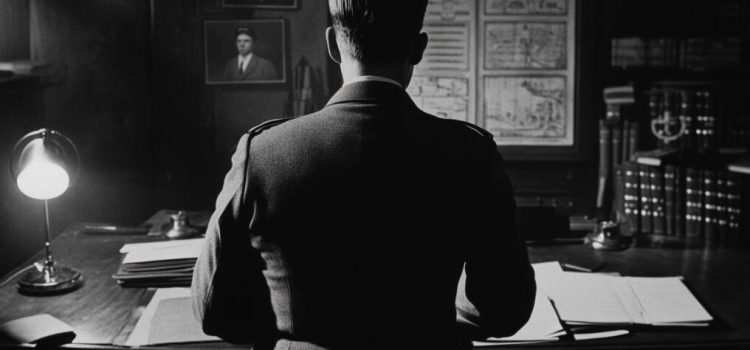

This article is an excerpt from the Shortform book guide to "Eichmann in Jerusalem" by Hannah Arendt. Shortform has the world's best summaries and analyses of books you should be reading.
Like this article? Sign up for a free trial here.
What did Adolf Eichmann do during the Holocaust? How did his role evolve as Nazi policies changed?
Hannah Arendt’s Eichmann in Jerusalem explores Adolf Eichmann’s involvement in the Nazi regime’s “Jewish question.” The book examines his progression from an advisor on Jewish emigration to a key figure in the transportation of Jews to concentration camps.
Continue reading for Arendt’s analysis of Eichmann’s role in the Holocaust to discover how his actions shaped the course of history.
What Adolf Eichmann Did as a Nazi
What did Adolf Eichmann do during his time as a Nazi? We’ll examine Eichmann’s role in the Nazis’ proposed “solutions” to the Jewish question—that is, the antisemitic question concerning the ideal treatment of Jews in Europe, whom the Germans viewed as a problem to be solved. We’ll see how Eichmann became considered an expert on the Jewish question in the first solution (convincing Jews to emigrate), how he brainstormed many logistical aspects of the second solution (deporting Jews to foreign lands), and how he was responsible for the transportation of Jews in the Nazis’ Final Solution (the systematic murder of Jews in concentration camps).
Eichmann’s Role in the First Solution
Arendt writes that, from early 1933 until 1939, the Nazis worked on the first solution, which sought to convince the Jewish people to voluntarily relocate to Palestine. She reports that Eichmann played an essential advisory role as an alleged expert on Jewish emigration during this time.
According to Arendt, Eichmann’s role in the first solution began in 1932, when he joined the Schutzstaffel (SS), the Nazi Party’s primary paramilitary organization. By 1938, the Nazis recognized Eichmann as an authority on the Jewish question. He even communicated directly with Zionist Jews (those who wished to develop a Jewish state in the Jews’ ancestral homeland of Palestine) to develop an infrastructure for encouraging Jews to leave Germany voluntarily.
(Shortform note: Although the Nazis initially collaborated with Zionist Jews in Germany, Palestine’s president Mahmoud Abbas went a step further in his 1982 dissertation, which claimed that these Zionists were the Nazis’ primary partners in crime and were therefore equally responsible for the Holocaust. However, some experts warn that this interpretation is inaccurate and borders on Holocaust denial, as the extent of collaboration was far smaller than Abbas suggests.)
Arendt notes that, in 1938, Eichmann received a promotion to first lieutenant of the SS and was put in charge of the Jewish Center for Emigration in Vienna, where he was responsible for the emigration of around 100,000 Austrian Jews. But, after Germany successfully invaded Poland in September 1939, it suddenly gained over two million more Jews. When Eichmann became head of the Reich Center for Jewish Emigration in 1939, it became clear that convincing two million Jews to emigrate voluntarily wasn’t feasible.
(Shortform note: The German invasion of Poland in September 1939 spelled not only the end of the first solution but also the beginning of World War II. Because Britain and France were allied with Poland, the Nazis’ invasion on September 1 led Britain and France to formally declare war on Germany two days later, on September 3.)
Eichmann’s Role in the Second Solution
Following Germany’s 1939 invasion of Poland, the Nazis’ official approach to the Jewish question turned to the second solution, which involved forcibly deporting the Jewish people to a foreign land. According to Arendt, Eichmann helped brainstorm different means of implementing the second solution, though the Nazis eventually abandoned his ideas.
In late 1939, Germany announced plans to deport Jews to the General Government—the part of Poland that Germany hadn’t annexed. As part of this plan, Eichmann was tasked with organizing the deportation of thousands of Jews from annexed Poland and the Czech Republic. However, because Germany lacked the trains needed to enact this plan, it never came to fruition.
(Shortform note: Although Germany didn’t annex the General Government in Poland, they nonetheless occupied it and ruled mercilessly over local Poles. According to experts, the Nazis exploited the local Poles as a source of cheap labor and took control over all Polish institutions, such as the Polish bank that monitored its central currency.)
After the plan to deport Jews to the General Government failed, Eichmann instead became the architect of the so-called “Madagascar Project,” which sought to deport over four million European Jews to Madagascar (then colonized by the French). Arendt reports that Eichmann spent the majority of his time in 1940 trying to arrange the logistics needed to ship four million Jews nearly 8,000 nautical miles away.
(Shortform note: Experts point out that because Madagascar was a French colony at the time, Germany intended to claim Madagascar for its own as part of France’s conditions of surrender. Moreover, they note that in initial versions of the Madagascar plan, the deported Jews living under German control in Madagascar would’ve served as hostages, preventing the Allied forces from retaliating against the Nazis.)
However, Arendt contends that in fact, the Madagascar Project was an obvious sham while higher-ups in the Nazi Party began planning for the extermination of the Jewish people. Every fact about the project pointed to its impossibility: The British Navy remained in control of the Atlantic Ocean; Madagascar couldn’t house four million new people; and it wasn’t feasible to attain the boats needed to ship four million people across the world in the middle of a war. Germany ultimately shuttered the Madagascar Project in 1942.
(Shortform note: The Madagascar Project was also implausible because of its proposed funding: Nazi Germany planned to subsidize the project through the sale of confiscated Jewish goods and donations from Jewish people worldwide. In other words, the Nazis intended for the Jewish people to pay for their own forced emigration.)
Eichmann’s Role in the Final Solution
As Arendt relates, some eight weeks after Germany’s 1941 invasion of the Soviet Union, Eichmann learned that Hitler had formally announced the start of the Final Solution—the systematic murder of the Jewish people. She writes that Eichmann was primarily responsible for the transportation of Jews to and from concentration camps.
Arendt points out that when Eichmann was later put on trial, neither the prosecution nor the defense questioned the facts about Eichmann’s role in implementing the “Final Solution” between early 1942 and 1943. Both sides acknowledged that Eichmann handled the logistics of gathering information about Jews in various ghettos and arranged for their regular transportation via train to concentration camps. Further, Eichmann admitted that he repeatedly visited these camps, including Auschwitz, where commanders showed him the shooting and gassing mechanisms used to murder Jews. In other words, he was fully aware that his trains were sending Jews to their deaths.
(Shortform note: While Arendt portrays Eichmann as an inept bureaucrat, other experts have argued that he was a far more competent and efficient leader than Arendt suggests. For example, some maintain that Eichmann’s forced emigration system was remarkably efficient. They also argue that, when Eichmann later arranged transportation to the death camps, he did so with merciless efficiency.)

———End of Preview———
Like what you just read? Read the rest of the world's best book summary and analysis of Hannah Arendt's "Eichmann in Jerusalem" at Shortform.
Here's what you'll find in our full Eichmann in Jerusalem summary:
- What “the banality of evil” means—and why the concept is controversial
- What drove the notorious Nazi official Adolf Eichmann to do what he did
- Why Hannah Arendt believed Eichmann was unremarkable






